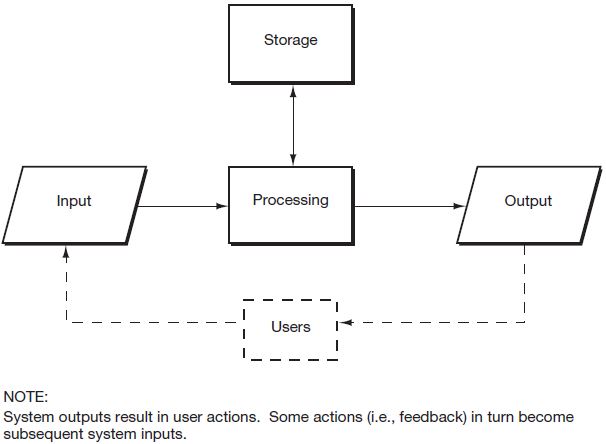An Information System is a man-made system that consists of an integrated set of computer-based and manual components established to facilitate an organization’s operational functions and to support management decision making by providing information that managers can use to plan and control the activities of the firm. Figure 1.3 depicts the functional components of an Information System. Imagine a simple IS used to maintain inventory balances for a shoe store. The inputs for such a system might be receipts of new shoes or sales of shoes; the process might be to update (in storage) the inventory records for the particular shoe; and the output might be a listing of all the various kinds and sizes of shoes and their respective recorded balances.
Assume that, while entering data about shoe sales, we also enter data about who purchased the shoes, how they paid for the shoes, and why they decided to buy their shoes at our store. We might store those data and then periodically print reports useful in making decisions about advertising effectiveness. Or, we might decide, on the basis of analysis of our sales data, to engage in joint advertising campaigns with a credit card company whose cards are often used in the store.
The shoe store example shows that an IS often divides into components based on the organizational function being supported. For example, the IS in the shoe store supports inventory control (a logistics function) by maintaining records for each shoe stocked in the store. The shoe store IS also supports a sales and marketing function by analyzing sales in a variety of ways. Other typical IS components include personnel, production, finance, and accounting. As discussed in Chapter 3, however, integrated computer processing has blurred the distinctions among these separate systems.

Now consider the technology components of the IS model in Figure 1.3. Input data are data received by the Information System from the external environment or from another area within the Information System. Data input includes capturing data (for example, scanning a bar code on a sales item at a grocery store) and, if necessary, conversionof the data to machine-readable form. Input data are normally recorded in business eventdata stores. 1 These business events comprise the activities of the organization, such as purchasing goods from vendors and collecting cash from customers. Business event data are used often as a key source of data to update various master data. A master data update is an information processing activity whose function is to incorporate new business event data into existing master data. Updating includes adding, deleting, and replacing master data and/or records. For example, the sales event data are used to update the accounts receivable master data by adding new accounts receivable records.
Master data updates are recorded on master data stores. Master data stores are repositories of relatively permanent data maintained over an extended period of time. 2 Master data contain data related to entities—persons (e.g., employees, customers), places (e.g., buildings), and things (e.g., inventory). Master data include such data as the accounts receivable master data, the customer master data, and the inventory master data.
Two types of updates can be made to master data: information processing and data maintenance. Information processing includes data processing functions related to economic events such as financial events, and internal operations such as manufacturing. Data maintenance, on the other hand, includes activities related to adding, deleting, or replacing the standing data portions of master data. Master data standing data include relatively permanent portions of master data, such as the credit limit on customer master data and the selling price and warehouse location on inventory master data. This textbook emphasizes information processing, and analysis of internal controls related to master data updates is restricted to master data updates from information processing. There are references however, to controls related to data maintenance at appropriate points in the text.
- 6906 reads






